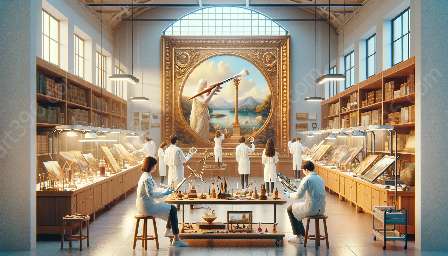Digital simulations have emerged as powerful tools in the field of art conservation, offering innovative solutions to preserve and restore precious cultural artifacts. This article delves into the significance of digital simulations in art conservation strategies, examines future trends in the field, and discusses the impact of these technologies on the preservation of art.
The Evolution of Conservation Strategies
Art conservation has long been a multifaceted and challenging endeavor, requiring a delicate balance between preserving the original quality of artworks and addressing the inevitable effects of time and environmental factors. Traditional conservation methods often involve meticulous manual restoration processes, which are both time-consuming and limited by the expertise of conservators.
Enter digital simulations - a game-changing advancement that has revolutionized the art conservation landscape. Through the use of cutting-edge technology, conservators are now able to create virtual replicas of artworks and simulate various conservation scenarios with unprecedented precision and detail.
Advantages of Digital Simulations in Conservation
The integration of digital simulations into conservation strategies offers a myriad of benefits. These simulations allow conservators to explore different restoration techniques without directly impacting the original artwork. By creating accurate digital models, conservators can test and refine preservation methods, ensuring optimal outcomes for delicate and valuable pieces of art.
Furthermore, digital simulations enable the visualization of how artworks might have appeared in their original state, providing valuable insights into their historical significance and aiding in the decision-making process regarding restoration techniques.
Enhancing Collaboration and Accessibility
Another critical aspect of digital simulations in conservation is the potential to enhance collaboration among experts in the field. By sharing digital models and simulation data, conservators and researchers can work together more effectively, contributing to a collective database of knowledge and best practices in art conservation.
Moreover, digital simulations have the capacity to make art conservation more accessible to a wider audience. Through digital platforms and virtual exhibits, the public can engage with conservation efforts and gain a deeper appreciation for the intricacies involved in preserving our cultural heritage.
Future Trends in Art Conservation
Looking ahead, the future of art conservation is undeniably intertwined with digital innovations. As technology continues to advance, we can expect to see more sophisticated and immersive simulations that facilitate increasingly refined conservation processes.
Machine learning and artificial intelligence are set to play a significant role in analyzing and interpreting data from digital simulations, potentially revolutionizing the way conservators approach restoration challenges. Additionally, the integration of virtual reality and augmented reality technologies holds promise for creating interactive and educational experiences centered around art conservation.
Impact on Art Preservation
The adoption of digital simulations in conservation strategies has already had a profound impact on art preservation. By leveraging these advanced tools, conservators can make informed decisions based on meticulous virtual assessments, leading to more effective and sustainable preservation practices.
Moreover, digital simulations contribute to the documentation and long-term monitoring of artworks, providing a valuable resource for future conservation efforts and research.
Conclusion
In conclusion, the role of digital simulations in conservation strategies is pivotal to the evolving landscape of art conservation. Embracing these technologies not only empowers conservators to safeguard our artistic heritage more effectively but also opens up new possibilities for collaboration, education, and public engagement in the realm of art preservation. As we venture into the future, the synergy between digital simulations and art conservation promises to be a driving force in shaping how we preserve and cherish the beauty of our cultural legacy.

